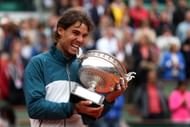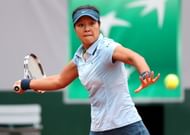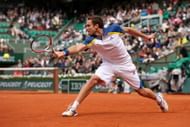The end of any reasonably significant event, let alone a saga as monumental as the French Open, should, theoretically, leave a big hole in our hearts. As we try to come to terms with the abrupt absence of players sliding all over the gritty courts of Roland Garros, the decisive disappearance of the topspin-infused shots that threatened to curve and arc right out of our TV screens, and, of course, the sudden silence that replaces the honest, salt-of-the-earth grunts that punctuated the gladiators’ efforts to battle for their lives, it’s almost obligatory on our part to feel a huge sense of loss. And yet, here we are, not two days removed from Rafael Nadal‘s historically epic beat-down of his countryman on the blood-soaked terrain of Court Philippe Chatrier, and we’re already taking in the green pastures of Halle and London, and poring our heads over the draws at the Gerry Weber Open and Queens.
It’s a good time to be a tennis fan, but not such a good one to be a sucker for nostalgia. So before the glorious memories of the 2013 French Open, of which there are many, are put in the shade by the austere grasscourts of Wimbledon, let’s take a look at the moments and mortals (or maybe even immortals) that, for better or for worse, defined this year’s tournament:
The Good
Gael Monfils seemed to have been scripting the customary feel-good story of the tournament, as he conjured one theatrical comeback after another to start the tournament. But just as he was settling down into a familiar chest-beating, crowd-exhorting pattern, something happened that no one expected: he ran into the real feel-good story of the tournament. 31-year-old Tommy Robredo has had his share of misfortunes through his career, not least of which is a far-too-obvious lack of weapons to consistently beat the top players, but he couldn’t have asked for a more charmed run at this year’s French Open. In his journey of recovery from injury and ill-form, a rejuvenated Robredo came back from a two-set deficit thrice in succession, leaving a trio of dazed opponents in his wake. Robredo’s combination of spin, court coverage and tenacity made for a potent and seemingly irresistible combination, as Igor Sijsling, Monfils and Nicolas Almagro found out to their dismay. His dream run was eventually stopped by David Ferrer in the quarterfinals, but by then Robredo had already stolen the hearts of the fickle Parisians and proved, once and for all, that 30 really is the new 20.
Speaking of David Ferrer, he won a few hearts of his own with his breakthrough campaign. He made his way to his maiden Grand Slam final without the loss of a set, displaying a ruthlessness and composure that few would have thought him capable of. Ferrer has always been professional to a fault, a trait he shares with his fellow runner-up on the women’s side, Maria Sharapova. In fact, the two losing finalists of this year’s tournament share a couple of similarities, notwithstanding the fact that their games are as different as chalk and cheese. Ferrer and Sharapova both don’t know when to quit, and they both went into the singles finals as disconsolately disproportionate underdogs. But props to them both for doing everything in their power to reach the finals, even if that meant putting themselves at risk of being humiliated by their seemingly invincible opponents. That only one of them got semi-humiliated is just icing on the cake.
Svetlana Kuznetsova set herself apart from the entire women’s field by being the only player to have the temerity to take a set off Serena Williams. Kuznetsova did more than just take a set off Williams, though; at one point she led by a break in the third set, and was, theoretically at least, in position to complete a stunning upset. The Russian has strong claycourt credentials, as anyone with a trophy at Roland Garros naturally would, and for a while she seemed to have flummoxed the World No. 1 with her big forehand and clever variations. Can she build on this to make a comeback into the top 10, where she clearly belongs? Trying to answer that question can get both messy and distressing, so let’s leave Kuzzy alone for the moment, and instead just reminisce about her memorable almost-upset.
The Sublime
I’ll just go ahead and say it: they should create a separate tour for Serena Williams, a tour where normally-imperious champions aren’t made to look like hapless toddlers. The aforementioned near-loss to Kuznetsova aside, there was nothing and no one that seemed even remotely capable of challenging the American, and her preposterous dominance of Sara Errani in the semifinal moved Sports Illustrated columnist Jon Wertheim to call it the “most one-sided match he’d ever seen”. And all this on a surface that is supposed to be completely alien to her game. Where’s that separate tour already?
As for Rafael Nadal, we’re going to run out of superlatives for his dominance on clay very soon. Some players take as many as three whole years to get back to their best after a long injury layoff, like Maria Sharapova. Some others get back to competitive play after a couple of years, but never regain their devastating pre-injury game, like Juan Martin del Potro. And still others struggle in the wilderness right until the end of their career, a la Lleyton Hewitt. What does Rafael Nadal do after his long injury layoff? Reach the final of the first 9 tournaments he enters, winning 7 of them, with the last one being a record-breaking 8th title at Roland Garros. In a comeback to beat all comebacks, Nadal overcame indifferent form, unfortunate scheduling, a spirited Novak Djokovic and about a hundred other smaller obstacles before opening his shoulders and emphatically defeating his countryman in the final to add yet another spectacular chapter to his legacy. I think I have run out of superlatives already.
As far as sublime sights at Roland Garros go, the 4th round match between Stanislas Wawrinka and Richard Gasquet has to rank pretty high up the list. For close to 4 hours, the two players did what they’re best at: producing the most delectable shot-making imaginable, hitting winners from all parts of the court and unleashing their gorgeous one-handed backhands time and again to elicit ‘oohs’ and ‘aahs’ from every single spectator lucky enough to watch the match live. The match ended 8-6 in the fifth in favour of Wawrinka, which, in terms of pure numbers, fell just short of the Nadal-Djokovic semifinal (which ended 9-7 in the fifth). But for the sheer audacity and beauty of the tennis that was on display, the Wawrinka-Gasquet match wins my vote for ‘match of the tournament’.
The Bad
It feels a bit strange, and maybe also a little harsh, to put Jo-Wilfried Tsonga in this category. But as well as he played to bundle Roger Federer out of the tournament at the quarterfinal stage, his subsequent collapse against David Ferrer in the semifinal was both unexpected and distasteful. It’s not the fact that he lost to Ferrer (who is an excellent claycourter by any measure) that was disappointing, but the way he lost. Tsonga has defeated the likes of Federer and Nadal at a Slam before, so his quarterfinal victory here wasn’t particularly ground-breaking. Sadly, the next step that we’ve been waiting for from Tsonga – the ability to string together two or three quality victories, rather than flame out after registering just one – was, yet again, sorely missing.
Tsonga’s fellow member of the ‘Big Boy’ club, Tomas Berdych, did a lot worse, flaming out before registering even a single win, let alone a quality one. And the biggest of the Big Boys, John Isner, got himself tangled in yet another marathon, except that this time he failed to eke out the win, and the marathon wasn’t anywhere close to being a classic of any sort. How many more of these torturous Isner five-setters will we have to sit through? The man is almost single-handedly making the case for the introduction of fifth-set tiebreakers at all the Slams.
On the women’s side, Li Na gave further evidence as to why she can never be trusted to consistently perform to her potential. Bethanie Mattek-Sands played exceptionally well in their second round match, but it was still Li’s match to lose, which she did without any qualms by putting up an uninspired display in the 3rd set. The supremely talented Chinese had shown signs of great progress by reaching the Australian Open final in January, but this is a big step back for her. The story of her career, really.
The Ugly
You’d think a sport that has seen the worst possible consequences of inadequate security (rewind to the 1993 on-court stabbing of Monica Seles) would be particularly careful about ensuring unimpeachable security at every single tournament. And yet, for the second time in four years, one of the biggest tennis events of the year was marred by a spectator invading the court and coming within striking distance of the eventual champion. Are the organizers waiting for another player to be stabbed, maybe even killed, before they implement more foolproof security measures?
The debate on whether to implement Hawk-Eye on the claycourts of Roland Garros continues to rage on. But Sergiy Stakhovsky’s frustration at the chair umpire’s supposed inability to make the right call, which led to him photographing the ball mark with his phone, may have tilted the argument slightly in favour of Hawk-Eye – a player photographing a ball mark is clearly a bad advertisement for the game. Besides, as noted tennis columnist Steve Tignor remarked recently, an umpire repeatedly getting down from his chair to try and decipher which one among the many ball marks is the right one makes the French Open look behind the times, maybe even a little regressive. If they can’t put a roof over the players’ heads, maybe they should go ahead and implement Hawk-Eye to give the impression that they are at least trying to keep pace with the other Slams?
The last word, as it almost never is, is reserved for Ernests Gulbis. The flame-throwing (both on and off the court) Latvian regaled and frustrated in equal measure during his high-quality 2nd round loss to Gael Monfils. But he made plenty of noise even before the match; in an interview with L’Equipe, he launched into the top players, calling Federer, Nadal, Djokovic and Murray ‘boring’ and accusing them of ‘putting on an act’ by being unfailingly courteous with their opponents. Gulbis went even further, saying that he’d like tennis to be more like boxing, where there is ‘war, blood and emotion’. Gulbis has never been shy of coming up with a quotable quote or two, and for the most part his interviews are hilarious and entertaining. But maybe he should try winning a little more often before he launches into poorly-timed tirades against his colleagues? He probably didn’t watch the Nadal-Djokovic semifinal, but if he did, he’d know that the top players, as Andy Murray so eloquently put it, are boring for a reason; they’d rather keep the focus on their tennis than their interviews, so that they can keep producing the belief-defying exhibitions of staggering athleticism that we’ve become accustomed to witnessing. If the cost of being in the Golden Age of tennis is putting up with less-than-thrilling player interviews, I can certainly live with that. It’s time Gulbis learnt to live with it too.
Who Are Roger Federer's Kids? Know All About Federer's Twins



